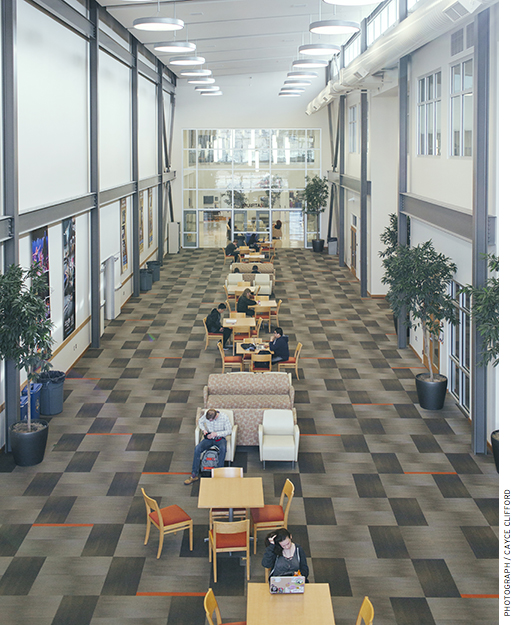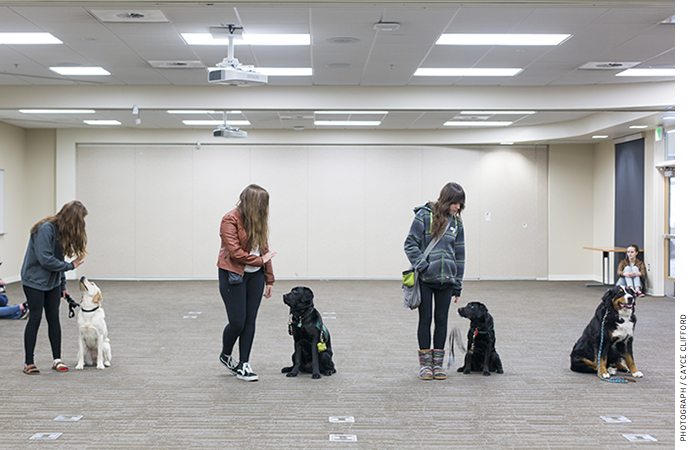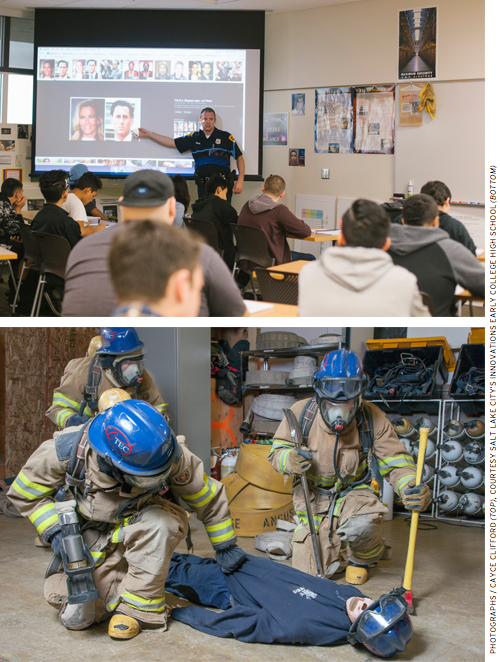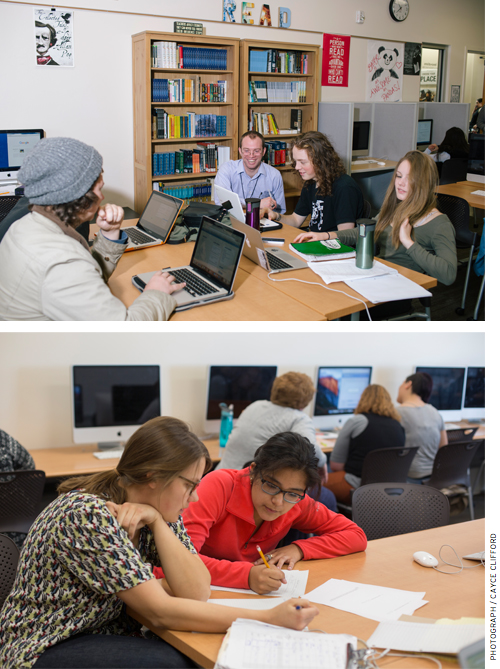There are no bells at Salt Lake City’s Innovations Early College High School, and no traditional “classes.” Students show up when they like, putting in six and a half hours at school between 7 a.m. and 5 p.m. Working with a mentor teacher, students set their own goals and move through self-paced online lessons. They can take more time when they need it or move ahead quickly when they show mastery.

This model would feel cutting edge almost anywhere, but it is all the more so at Innovations, a public high school that was founded by the Salt Lake City School District four years ago. The district designed Innovations to capitalize on “blended learning,” a mix of online and teacher-led instruction. Ken Grover, the school’s founder and principal, proposed a school that would put teenagers in charge of their own education. Innovations draws high, average and low achievers who crave that freedom.
The school attracts “students who the existing system has failed,” said Michael B. Horn, a blended-learning consultant. “It’s really ‘bleeding edge.’ They don’t really have classrooms.” While individualized online instruction has become prevalent in many high schools, it is mostly used as an add-on, to offer special classes like foreign languages or credit-recovery courses. As a major aspect of a school model, it is more readily associated with charter schools, such as Summit Public Schools and Rocketship in Silicon Valley.
Innovations is among a small group of district-based trailblazers to use the “flex model” of blended learning as its foundation. Last year, the Christensen Institute, co-founded by Horn, cited Innovations as one of a dozen “proof points” nationwide for blended learning.
With help from the new federal Every Student Succeeds Act (ESSA), blended learning could move from the margins to the center at more district schools. The law supports state-led innovation broadly, and provides funding for states and districts to implement personalized, blended, and online learning.
Indeed, Horn believes that the Innovations model is “where high school is going in the long run.” But, he cautioned, “if you don’t have the right culture in place and teachers haven’t bought in, it can go horribly wrong.”

Students Set the Pace
Innovations is growing in popularity. Now in its third year, the school serves 360 students, with another 150 late applicants on a waiting list.
In 2012, when Innovations was under development, the district was looking for ways to raise its graduation rate. Grover, who’d led a traditional Salt Lake City high school as well as the district’s career and technical programs, asked students what they liked and disliked about high school. What did they want?
They said they valued the relationships they’d made, and “even the learning,” but felt the school day was “structured to the needs of teachers and sports teams,” he said.
Plus, they reported, school was “boring.”
What did that mean?
Students said that if they didn’t understand something, they couldn’t get their questions answered right away. Teachers with a whole class to manage couldn’t slow the pace to deal with one student’s confusion.
For other students, the pace was too slow.
For someone who’s confused, or already knows the material, those 90-minute classes could be “painful,” Grover said. “I think it’s one of the primary reasons students walk away from school.”
Students wanted to “come when they wanted, work at their own pace, and be treated like adults,” he said.
Today, Innovations students do just that while also taking advantage of the early-college and career-tech opportunities that the school’s location encourages.
Innovations occupies the corner of an airy new building on the South City campus of Salt Lake Community College (SLCC), along with the district’s Career and Technical Center (CTC). The state reported that last year about 1 in 10 Innovations juniors and seniors took community-college classes and more than half took courses through the CTC, whose offerings range from computer programming and CD graphics to barbering and nail design. In addition, students may ride a shuttle bus to their local high school to participate in classes or extracurriculars, such as choir, band, foreign language, or sports.
This flexible model appeals to students with diverse goals.
Sophomore Jenny Le is looking to turbocharge her high-school years. She hopes early college classes will enable her to earn a university degree in two years, getting a head start on medical school and saving money, and she is already thinking about how old she’ll be when she completes her medical residency.
Career tech and a small-school environment drew Jacquie Robb, also a sophomore, to Innovations. She’d heard that animal science students qualify to train a guide dog. She put that off to take a law enforcement class—“taught by police officers,” she pointed out—and then fire science, “taught by firefighters.” She now wants to become a police officer and “catch the bad guys,” she said.
In addition, both girls took an emergency medicine class taught by an EMT, which can lead to employment-ready certification when they turn 18. The class appealed to Robb’s interest in first-responder careers, and Le’s plan to work her way through college, on her way to becoming a doctor.
Last year, Innovations had its first student—a Latino male—graduate with an associate degree as well as a high school diploma. This year, five to seven 12th graders are on that track, Grover said.

An Early Exercise in Adulthood
At first glance, it all seems loosey-goosey.
Innovations has bare-bones “classrooms”—with tables, chairs, and computers—but no classes in the traditional sense. At any given time, there are likely to be some students working independently or with a partner and a teacher talking with one to four students.
A few early birds show up at 7 in the morning, but most students start their day between 9 and 9:30, and a few don’t arrive till midmorning. After logging on to the learning management system, which shows personal goals and progress data, a student decides what to study and when to move on. Bored with bio? Pop into the English room to watch The Taming of the Shrew or polish an essay. Students can take more time on an assignment when they need to, or move ahead quickly to the next thing when they demonstrate mastery.
Throughout the day, small groups of students form to collaborate on projects or labs. They may choose the same book to read for their English course so they can discuss it together. Other students opt to work alone. Meanwhile, tutors and teachers walk around looking for students who need help, or meet by appointment to work with individuals or small groups.
The school follows the district curriculum, which is aligned to Common Core State Standards. Everyone takes English language arts, math, and two other classes at a time, unless a counselor agrees to more.
Despite the do-your-own-thing atmosphere, students are expected to complete at least eight classes a year. Teachers and mentors track each student’s progress and step in when a student isn’t moving fast enough to stay on track for graduation.
Career tech and community college classes are taught face to face. Innovations students are expected to figure out where they need to be and when they need to be there.
It’s a combination of self-directed study and responsibility that can help students get ready for life after graduation—on the job or at college—when it’s executed well.
“The right personalized-learning model” can engage students who haven’t done well in traditional schools, said Don Soifer, executive vice president of the Lexington Institute, who’s researched blended learning. Teachers “are able to spend less time ‘teaching to the middle’ and more time connecting with students as individual learners.”
But not everyone thrives in a self-directed environment, at least not at first, said Andrew Calkins, deputy director of the Next Generation Learning Challenges initiative at Educause, which supports learning-technology innovations. (Innovations is not a grantee.) “We’re finding with our grantees that a third of students do very well in this model, a third will adapt in a semester, and the final third need a lot of help to make the transition,” he said.
Diana Senechal, a high-school philosophy teacher who warns of the distractions of technology in her book Republic of Noise, sees a downside in letting students “tailor their learning to their own needs and preferences.” She asked, “How will they ever be challenged?”
“What Are You Supposed to Do All Day?”
Innovations students are partnered with a mentor teacher who will guide them through all four years of high school. Mentor teachers meet at least once a week with students, and four times each year with students’ families. They also e-mail and text families, and send home paper transcripts each month for easy display on the refrigerator door. The communication and transcripts are designed to explain where each student is, and where he or she should be.

“You can’t hide here,” said Grover, who attributes the success of Innovations to a strong culture and cadre of teachers. “Some of our students don’t like that.”
Heather Bauer is in her third year as an English teacher at Innovations. Previously, she taught in a traditional classroom setting at a charter school.
“At first, I thought, what are you supposed to do all day?” said Bauer, who noted she now loves her role. “I know my students so much more, and I can teach at a different level. I can delve deep.”
Bauer starts her day at 7 a.m. Not many students arrive that early, so she has time to send e-mails, grade papers, tweak units, and hold mentor meetings. Then, from 10 a.m. to noon, she gathers small groups of students for class meetings or individual coaching—discussing strategies with a student who needs backup for his thesis statement in an essay, for example.
Throughout the day, she will gather students—who may be in different rooms—for a “class meeting” to discuss a concept. Students who’ve already mastered it need not participate. Usually, students are working independently, or with a friend, while the teacher coaches one student at a time. Teachers stagger their work schedules so there’s always a math teacher and an English teacher available onsite.
It can be frustrating to teach a lesson to two students, and then do it again with another two who weren’t available before, said Bauer. But while she was teaching to a classroom of students at one time in a conventional school, she said, “I felt I was just talking to myself.”
The opportunity to revisit lessons is baked into the Innovations model. Since classes don’t follow any particular schedule, students can complete them as slowly or as quickly as time and preparedness allow. To complete a class and earn credit, students must show 70 percent mastery of 100 percent of the content, and cannot progress to the next class until they do. In addition, they can return to classes they’ve finished if they want to improve their grades. A teacher will “reactivate” the subject and show what work students can do to raise a “C” to a “B,” or a “B” to an “A.”
In other words, “you can’t get an F,” said Grover, the principal. You only can get more time.
Accordingly, teachers play multiple roles to keep students on their many tracks. Bauer mentors individual students in all four grades, and is also responsible for the English language arts progress of 200 students in the 11th and 12th grades.
Teaching at Innovations can be labor-intensive, she said, especially among 9th-grade students, who come in expecting to be “led from one class to another” and earn credit by sitting quietly.
They have to learn to handle freedom, she said. When they do, “the fact that students take ownership of their education” makes all the difference.
Unique Goals, and a Unique Culture
Despite Salt Lake City’s image—white and Mormon—city schools serve an ethnically diverse student body. At Innovations this year, 42 percent of students are white and 30 percent are Hispanic, with multiracial, Pacific Islander, African American, Asian, and Native American students attending in smaller numbers. More than half of students qualify for free or reduced-price school lunch. Some 17 percent are English language learners, and 7 percent receive special education services.
Innovations also enrolls students with a range of historic academic performance. Among entering students, about 15 to 20 percent perform above grade level, about 15 to 20 percent below; the rest are in the middle, said Grover. Each student has an individualized education plan.

Innovations students take state exams, just like students at Salt Lake City’s four other district high schools. Teachers analyze results to see how well students are meeting learning objectives.
After a shaky first year, the school’s graduation rate rose to 89 percent in 2014, hit 93 percent in 2015, and is projected to reach 95 percent in 2016. That’s significantly higher than the district and state average. In addition, Innovations students earn more college credits than those at the city’s other high schools combined. Many Innovations graduates go on to SLCC and the University of Utah and other public institutions, Grover said. Achievement among Latino students is a particular point of pride.
Students and teachers also praised their school for offering an encouraging, intimate atmosphere.
For all the computer time, Innovations is a high-touch school, said Jenny Le, the aspiring doctor. “You get moral support here. The teachers all learn your names. If I reach a goal, my mentor says, ‘Jenny did it!’ in a really loud voice so everybody knows.”
Craig Ellis, who is working as a math tutor while he completes his teaching degree, said he loves the one-on-one time he gets with students and the opportunity to build long-term relationships over their high-school careers. At the graduation ceremony, the mentor hands the diploma to the graduate. “It’s a big moment, very emotional,” he said. “I’m looking forward to it.”
Jacquie Robb, the aspiring police officer, said she was bullied in middle school, where cliques and “mean girls” ruled the day. She arrived at Innovations too shy to ask teachers or tutors for help in math, her weakest subject. Then a classmate—a girl who’s “going to be Einstein,” Robb said—helped her in math. “I was so quiet when I came here. They opened up my shell. I feel loved here.”
At Innovations, people “cheer you on,” she said. “You don’t have to look perfect every day.”
Unlike other Salt Lake City schools, Innovations has no behavior management plan, because it’s not needed, said Grover. As principal of a traditional high school, he dealt with fights every day; at Innovations, there have been none. He has not suspended a student, ever. “When a child isn’t frustrated, and is having their needs met, they don’t lash out,” he said. “We build support structures here.”
The Price of Flexibility
Innovations had few obvious peers when it opened in 2012. The closest parallels were the private micro-schools, such as AltSchool and Acton Academy, and Summit Public Schools, a charter network in Silicon Valley that incorporates a variety of learning software into its programs.
Now, Innovations-inspired district schools have opened in Idaho and Indiana, and more are planned in Arkansas, Oklahoma, Virginia, and Atlanta, Georgia, said Horn of the Christensen Institute. At least a thousand visitors have toured Innovations since it opened, said Grover, who frequently speaks about his school at conferences.
As in Salt Lake City, “districts are starting to create lab schools to try personalized, student-centered strategies with hopes of finding what will transfer to traditional schools,” said Calkins of Educause. ESSA, he said, “hangs a big welcome banner for this kind of model . . . Thanks to ESSA, the pace of experimentation will pick up.”
ESSA includes the Student Support and Academic Enrichment Grant program, which is authorized at about $1.6 billion annually and can support blended learning. Probably the most critical piece is funding training for teachers so they can figure out how to use digital tools effectively.
Innovations is doing blended learning on a shoestring. Utah ranks last in the nation in per-pupil spending, and Innovations gets the same relative pittance as Salt Lake City’s conventional high schools: $3,100 per student for operating costs and $3,200 for facilities-related costs.
It saves money by not offering electives or extracurriculars; students visit their neighborhood high schools for those. As at other Salt Lake City high schools, the student-teacher ratio is 29:1.
However, Innovations pays tuition for students who take community college classes and pays a fee for CTC enrollees.
Students use iMacs or MacBook Air laptops, or bring their own. The learning management system and the digital content, curriculum, and grading are provided by Spark Education (formerly iGo), and PowerSchool tracks student information. Teachers edit student work and add questions during their review using customizable software.
A student who’s taking a full load at SLCC is costly. “Our relationship to the community college is like any marriage that’s struggling,” said Grover. “You fight over children and money.”
Still, Grover—whose own daughter chose to enroll in Innovations—wants that marriage to grow. Someday, he hopes, half of Innovations students will graduate high school having also earned an associate degree or certificate.
The secret to its current and continued success is simple, he said. “We create a culture, curate content, and hire the right teachers.”
Joanne Jacobs, the author of Our School, is a freelance writer and education blogger at joannejacobs.com.
This article appeared in the Summer 2016 issue of Education Next. Suggested citation format:
Kronholz, J. (2016). Teacher Home Visits: School-family partnerships foster student success. Education Next, 16(3), 16-21.


